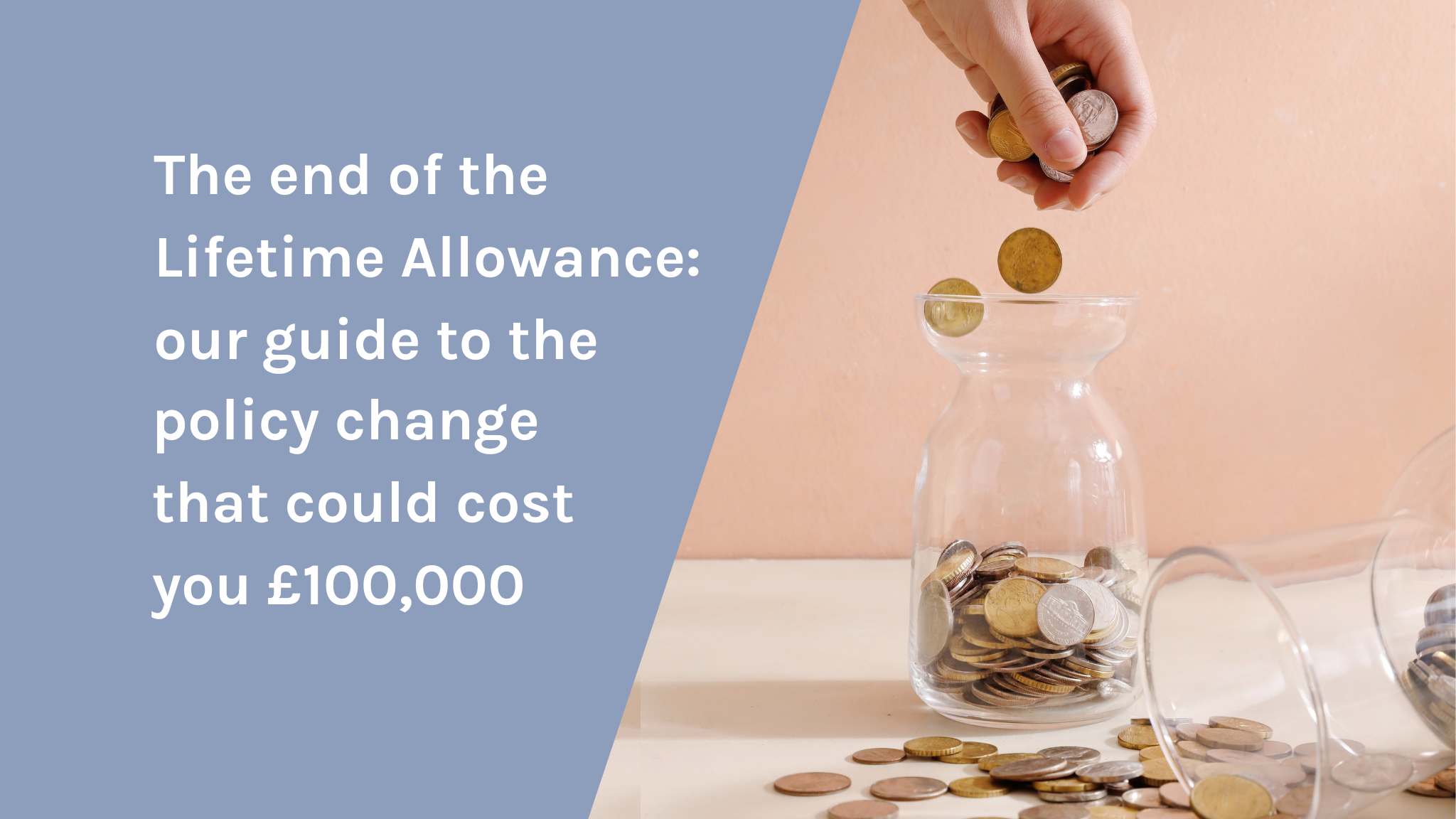
Elements of this article were updated on 28th February, following the passing of Royal Assent to the The Finance Bill 2023/24.
James Whittington is an independent Chartered Financial Planner. Since graduating from Cambridge University, he has built up over 15 years’ experience across the finance industry, covering investment banking; investment modelling and risk management within the Lloyd’s of London market; and personal financial planning.
Here at Montgomery Charles, have been advising for some time on a policy change that could have enormous implications for anyone hoping to make the most of their retirement.
I’m referring to the removal of the Lifetime Allowance – something which moved a step closer when the policy received Royal Assent on 23rd February, as part of the Finance Bill 2023/24. Barring something drastic, the changes will come into effect on 6th April.
Make no mistake – this is a complicated and evolving area and the cost of taking action and getting it wrong, or taking no action at all, could be significant.
In short: if you have taken an NHS pension out in the last few years, you could be missing out on up to over £100,000 of tax-free cash if you don’t act immediately. You need to seek financial advice before you next access your pension.
The good news? We’ve been planning for such a change for years, and we know exactly how to help. Our LTA Clinic allows you to easily book a no-cost, no-obligation chat to explore how this might affect you – you can do that here.
We’ve also put together a 90-second video guide to the LTA changes, plus a more detailed breakdown – you can find all of that below.
The right course of action will depend on your particular circumstances – so please do get in touch to see how we can help.
So what’s going on?
In mid-March 2023, a new policy change was announced that represented a seismic shift in the world of wealth management. Chancellor Jeremy Hunt announced in his Spring Budget that he was not only increasing the pension annual allowance (the amount you can pay in to a pension and receive tax relief on) – he was also abolishing the Lifetime Allowance (LTA). The LTA is the amount of money you can pay into a pension over your lifetime on which you would benefit from tax relief on the way in, and was tax-favoured when you came to take it out or start receiving your NHS pension income.
The annual allowance and LTA were both introduced in 2006 to limit the tax benefits of pensions for people on both an annual and lifetime basis. Since then, there has been an overall trend to reduce the allowances available to individuals – both on an annual and lifetime basis – to ensure government coffers were not overly depleted through lost tax revenue.
Until now.
Rewind back to March 2020, and the uncertainty and worry that gripped the nation as the scale of the Covid-19 pandemic became apparent. The government wanted to encourage retired doctors, medical sector workers and other public sector champions to take up the mantle once again and help the country through its biggest crisis since the Second World War. Many were happy to do so, but were quick to point out the potential financial implications and large tax penalties they could face by starting to work again, and by (rightly) being re-enrolled as an active member in their respective public sector pension scheme.
Three years of pressure later (combined with a disastrous but fortunately very brief interlude from his predecessor), Jeremy Hunt decided to remove the Lifetime Allowance.
By some, the Lifetime Allowance was viewed as a punitive limit on people doing the right thing (in saving for their future financial security and for having long careers) and so removing it would only be fair. Others saw the removal of the LTA as a cynical bid to win back votes – a view not helped by the last-minute nature of the policy, announced three weeks before the new tax year. Two decades of policy, legislation and complicated layers of transitional protections and rules were seemingly being thrown out the window by a three-page summary and no detail on how it would be implemented.
Putting the political divisions aside, as an interim stop-gap, the government announced that the LTA would remain, but the charge would be reduced down from 25% or 55% to 0% from 6th April 2023 to 5th April 2024. Additionally, the annual allowance would increase from £40,000 to £60,000 (and the tapered annual allowance from £4,000 to £10,000).
Fast forward to February 2024, through one of the fastest ever financial industry consultations several rounds of draft legislation and guidance. We now have Royal Assent and the LTA is set to be removed entirely from 6th April 2024. It should be remembered that the government has issued itself with powers to make further changes until April 2026.
Whatever your political views, it certainly presents a number of new and exciting opportunities for some – and we are actively advising our clients on where we have identified opportunities that apply to their situation. In particular we are seeing significant opportunity for people that have already accessed their NHS pension or are thinking about doing so in the near future. However, it also creates a number of pitfalls – so taking the right approach and seeking expert advice is imperative.
Heard enough?
Use the calendar below to book a no-cost, no-commitment chat with one of our advisers to see how specialist advice could help your financial position.
What are the Main Changes?
Lifetime Allowance
The Lifetime Allowance limited the total amount of tax-relieved pension savings that an individual could build up over their lifetime, across all of their pension schemes, without incurring an additional tax charge.
Most recently, this was capped at £1,073,100 (unless additional protection had been applied for). A benefit test was triggered by certain events – known as Benefit Crystallisation Events (BCEs) – such as, starting to receive your NHS pension, taking pension funds under a private pension drawdown, or when individuals passed away. In addition, a test would be carried out at age 75. Benefits in excess of the Lifetime Allowance at the time of these tests would result in a fixed tax charge of 55% if a lump sum was taken, or 25% if income was taken (with remaining excess taxed at marginal rates of income tax).
The LTA charge was reduced to 0% with effect from 6th April 2023. The Lifetime Allowance test as a whole will be scrapped in full from 6th April 2024.
From April 2024, only potentially non-taxable lump sums (i.e. tax-free cash) will be subject to a test against the limits, now known as a Relevant Benefit Crystallisation Events (RBCEs). Benefits in excess of the limits will be subject to your marginal rate income tax.
Instead of the Lifetime Allowance, this will be replaced by two main limits:
The Lump Sum Allowance (LSA)
This is the maximum tax-free lump sum that you are able to receive across all of your pensions during your lifetime. This is capped at whichever is lower: 25% of your total pension fund values; or 25% of £1,073,100 (the previous Lifetime Allowance figure) i.e. £268,275. If you have any existing protection in place, you may be entitled to a higher LSA.
Any payments above this threshold will be taxed at your marginal tax rates. It is important to note that this cap is calculated on an accumulated basis: each time tax-free cash is paid, this will be deducted from your LSA. If you have already taken money from a pension prior to 6th April 2024, your LSA will be reduced accordingly.
Lump Sum and Death Benefits Allowance (LSDBA)
This is the maximum total benefits that you can be paid out from any of your pensions, tax-free (including the LSA). As well as the LSA, it takes into account death benefits paid out to beneficiaries as a lump sum. The standard allowance will be set at £1,073,100. However, those with existing protections (i.e. fixed or enhanced protections) will have an increased LSDBA based on their protections.
If you die before age 75
On the member’s death, any remaining LSDBA (less the LSA used by the member in their lifetime) can be used to pay lump sum death benefits to the beneficiaries, free of tax. The lump sums are measured against the remaining LSDBA and where they are within this limit, there is no tax to pay. If they exceed this limit then they are taxable at the recipient’s marginal rate of income tax.
If the recipient receives income instead of a lump sum, then there is no test against the LSDBA and so no tax to pay.
If you die from age 75 onwards
If a member dies from age 75, then both income and lump sums are taxable at the recipient’s marginal rate of income tax.
Effectively this means in the majority of cases there is no change to pension death benefits, compared to the current position.
There is also a limit in respect of overseas pension benefits but as this will not apply to the majority of people, I will not go into this highly technical and specialist area here.
Annual Allowance
The Annual Allowance limits the amount someone can receive into their pension schemes each year that receives tax relief. This includes contributions paid by themselves, their employer or a third party. Where you have an NHS pension, the annual allowance is measured not by the amounts paid into the scheme from your salary, but by the value this will increase your future benefits by. The limit from 6th April 2023 is £60,000 per tax year (increased from £40,000 for tax year 2022/23). The annual allowance is tapered (reduced) for higher earners. It is reduced by £1 for every £2 someone earns over £260,000. This figure includes earned income, pension contributions, rental and investment income and workplace taxable benefits.
Carry forward can still be used in respect of unused allowances for the previous three tax years but continues to be based on the annual allowance limits that were in place during those years.
How do These Changes Affect You?
The technical summary is all well and good, but what do you actually need to know?
Well, some people in certain situations could stand to benefit significantly from these changes. These include:
Scenario 1: You have previously used some or all of your Lifetime Allowance and have limited or no scope to take further tax-free cash (this is particularly relevant for people who have taken reasonably large final salary pensions, such as an NHS pension).
Scenario 2: You are about to access a defined benefit pension (such as the NHS pension) and are unsure on how much tax-free cash to take (this follows on from Scenario 1, but assumes you haven’t yet started taking the income).
Scenario 3: You have Enhanced Protection or Fixed Protection and have therefore been unable to contribute further to your pensions, for example you have had to opt out of the NHS pension to preserve your protection.
Scenario 3a: You have Enhanced Protection or Fixed Protection and have had your funds depleted by a Pension Debit (e.g. Pension Sharing Order on divorce).
Scenario 4: Annual Allowance and new Lifetime Allowance Rules Combined. With the removal of the Lifetime Allowance, you are no longer limited in how much you want to save towards your retirement over your lifetime, or to pass on to future generations tax-efficiently. With the right financial advice, You can effectively build a pension pot or a succession planning pot as large as you want.
A word of warning. The latest HMRC guidance states that if you ask your pension provider to calculate whether you are entitled to extra tax-free cash (and you are, unknowingly, entitled to less than you would get under the new allowances), you actually lock in a lower allowance than you would have otherwise get. This effectively penalises you for trying to find out if you are entitled to extra tax-free cash.
Speak to an Expert
This is a complicated and evolving area, and the cost of taking action and getting it wrong, or taking no action, could be hundreds of thousands of pounds.
Every scenario needs to be evaluated on a case-by-case basis and as such, this article does not constitute financial advice.
If you would like to speak to an expert on what the Lifetime Allowance changes mean for your situation and what opportunities are now available to you, please schedule a no-cost, no-commitment consultation with one of our financial planners.




